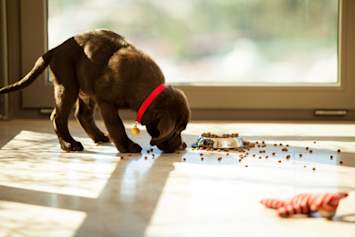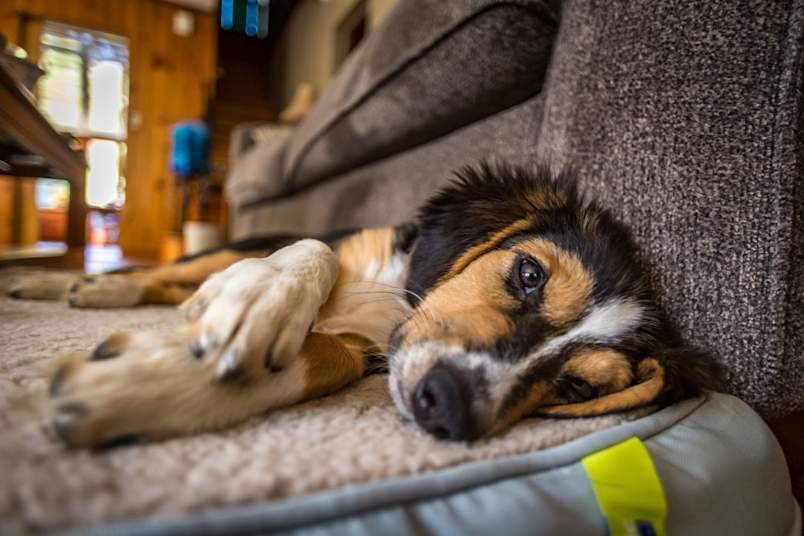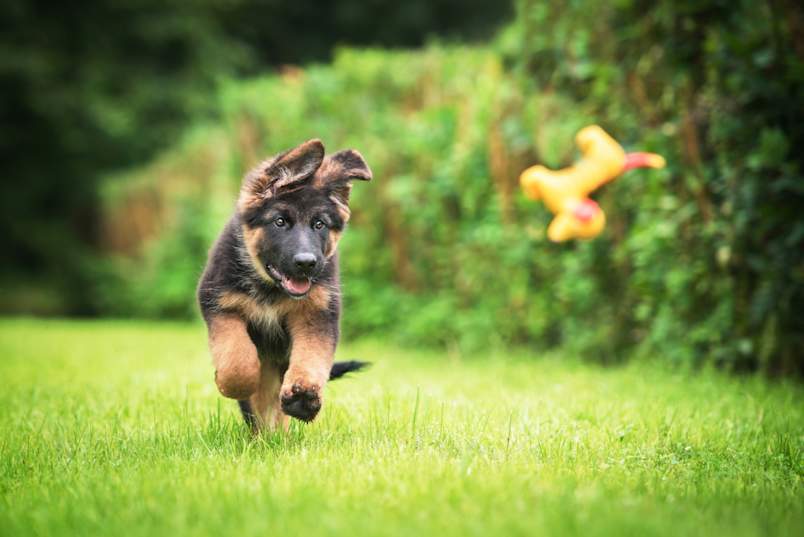
The first 48 hours with a new puppy are filled with excitement. You learn a lot about your pet’s personality and needs as they get acquainted with their new home. To make the transition go as smoothly as possible, it’s important to stock up on some puppy essentials.
At Embrace Pet Insurance, we’ve compiled this puppy essentials list to help you care for your dog and create a stress-free first few days together.
Puppy Essentials Checklist
Checking items off your new puppy checklist can make you feel confident on the big day when you bring your canine friend home. Buying things like food and collars is a given, but there are many things first-time dog owners may not realize they’ll need. The typical puppy schedule includes lots of playtime and training, so you’ll need items to keep your pup safe and entertained.
Puppy Health and Safety Items
Some of the most crucial puppy supplies are the ones required for their safety. Invest in the right items for your dog’s health to give them a long and happy life.
Collars and Harnesses
Getting your dog a collar or harness is essential so that you can safely take them on walks and to their veterinarian appointments. Collars are easier to use but may put a strain on your puppy’s neck. A harness can be better for dogs with certain medical issues or who pull a lot.
Leashes
Purchase a leash so that your puppy won’t run off while you’re taking them to the bathroom or around town. Leashes come in a range of weights and sizes, so make sure to buy one that is the right fit for your puppy. Be prepared to practice a bit with your dog before they get the hang of walking correctly on a leash.
Identification Tags and Microchips
Even the most vigilant pet owners can lose sight of their dog at a busy park or in their backyard. You can purchase an ID tag to attach to your dog’s collar. This tag should include your dog’s name and your contact information. Your veterinarian can also implant a microchip in your dog. If your dog ever gets lost, a shelter or veterinarian can scan the chip and get your contact details.
Feeding Supplies for Your Puppy
Growing puppies need adequate nutrition, and no puppy checklist is complete without plenty of food and water.
Food and Water Bowls
While items as simple as food and water bowls can seem basic, you’ll still want to put some thought into the type you buy. Depending on the size of your puppy, you may need bowls that are very low to the ground. For puppies that are especially boisterous, consider bowls with a rubber grip on the bottom to prevent the bowl from moving around and avoid spills. Some puppies are ravenous eaters, so slow-feeder bowls may be a better option than traditional bowls to help slow them down. For dogs that will travel with you often, consider also buying portable water containers to keep in your car.
Choosing the Right Dog Food
Puppy food is specially formulated with nutrients geared towards growing dogs, such as appropriate amounts of calcium, protein, and fat. Make sure the food you buy is intended for puppies, not adult dogs. Puppy foods labelled for certain dog breeds or a puppy’s future frame size (e.g. large breed formulas vs. small breed formulas) can be especially helpful for some dogs. In addition to the right kinds of nutrients for growing puppies, smaller kibble is often needed because puppies can choke on pieces of kibble that are too large for them. Remember that an abrupt change in diet can cause an upset stomach, so if possible, talk to the shelter or breeder and find out what they were using for the puppy. If you need to switch foods, start off with the same food your pup is already used to eating and then gradually transition them to the new food.
Treats and Chews
In moderation, treats and chews can be a delicious way to supplement your dog’s diet, and they can help with training. As with your puppy’s daily food, ensure the treats and chews are suitable for your dog’s age and size. Remember to use treats as an addition to their regular diet, rather than as their main source of nutrition.

Puppy Training Tools
Training can be a fun and sometimes frustrating part of living with a dog. There are tools to make the training process easier.
Training Treats
Most puppies are very food-motivated. Having a bag of training treats on hand is a good way to reward good behavior (e.g. learning commands, using the bathroom in the correct location). Training treats are typically small and low-calorie so that they don’t disrupt your dog’s diet.
Treat Pouches
Invest in a treat pouch that you can take with you as you travel with your new puppy. This way, you can practice on-the-go training with them outside the home.
Grooming Supplies
When you’re shopping for new puppy essentials, don’t forget grooming supplies. Grooming your dog isn’t all about looking pretty – it's about health, too!
Brushes and Combs
Some dog breeds with long fur will need to be brushed regularly. Buy a brush and comb to prevent tangles or matted fur and to remove dirt and debris that your curious puppy is sure to accumulate.
Nail Trimmers
Like humans, dogs need their nails trimmed. Untrimmed nails can make walking painful. If you aren’t comfortable trimming your puppy’s nails, you can take them to a veterinary clinic, certain pet stores, or professional groomers.
Shampoo and Grooming Wipes
Does your new puppy or dog need to be bathed often? Not necessarily, but some dogs have a tendency to get messy, whether that’s from rolling in mud puddles or going for a swim in the lake. Buy puppy or dog shampoo and grooming wipes to keep them smelling fresh and clean without irritating their skin. Avoid human soaps and shampoos as these can be too harsh on them.
Dental Care Products
Did you know dogs’ teeth can accumulate plaque? Add a puppy toothbrush and dog-friendly toothpaste to your shopping list to keep their teeth sparkling. Be prepared to patiently teach your pet how to tolerate having their teeth brushed- it is a novel concept for them to allow a person to stick things in their mouths.
Puppy Home Setup
Your puppy supply list should also include supplies for your home. While you won’t need to make any major renovations to welcome your new dog, there are some things you can buy to keep your house a safe space.
Crate and Crate Training
Puppies are notorious for chewing on shoes, paper, and pillows. Crate-training your dog for when you’re away can prevent them from ingesting toxic substances and ruining your furniture. Purchase a crate that’s an appropriate size for your pup. They should be able to comfortably stand up and turn around. If the crate is too big, they may use part of it as a make-shift bathroom.
Baby Gates and Barriers
If your home has stairs or rooms that aren’t safe for dogs, baby gates are a great way to keep your puppy out of harm’s way. These can be put in doorways and hall entrances. In fact, when you first introduce your pet to their new home, you will want to minimize how much room they have to roam until they become comfortable with their environment. This could mean that you need to buy more gates/barriers than you might think, depending on the size of your home.
Bedding and Blankets
Invest in a comfy bed and blanket for your puppy. A fluffy bed can help your dog feel right at home, especially in the lonely evening hours. Make sure the material is durable and doesn’t shred easily as some pets tend to tear up their bedding when bored or anxious.
Toys and Playtime for your Pup
Puppies are high-energy. Keeping them occupied can reduce unwanted behaviors (like barking and chewing) and is fun for them both physically and mentally.
Chew Toys
There are tons of chew toys on the market, and it may take some trial and error to see which ones your puppy loves. Durable rubber chew toys can help give your dog an outlet for their natural desire to chew. Dog toys vary by size, so be sure to check the label for age recommendations. Be wary of rawhides or chews that your dog can accidentally swallow if they tend to be hardy chewers.

Puzzle Toys
If you’re trying to figure out how to stop a puppy from barking, try out some food puzzle toys. These are typically large plastic, cloth, or rubber items that you can hide treats inside. They encourage a pup to get creative to figure out how to find the treats, which is great for their growing brains and fun for you to watch!
Interactive Toys
Some dog toys, like stuffed fish that flop around or squeaky toys, are interactive. They make fun noises when played with or move around so your dog can chase them. Others, like a ball launcher, are a way for your dog to play fetch even when you’re gone.
Plush Toys
Many puppies love carrying around a soft, plush toy. These are stuffed animals that the dog can chew on or lay on. Keep an eye on your dog if you aren’t yet sure how strong of a chewer they are. Some dogs can rip through a stuffie within minutes, so these types of toys might not be right for them.
Cleaning Supplies
While not quite as fun as shopping for toys, cleaning supplies are definitely puppy essentials. These items need to be on hand when you’re dealing with typical behaviors like puppy vomiting or bathroom accidents.
Vacuum Cleaners
Some dogs shed year-round. Investing in a vacuum cleaner that’s designed to remove fur from carpets and flooring will help your home stay looking presentable.
Stain and Odor Removers
Puppies need to be house-trained. Before they learn how to go to the bathroom outside, you might be cleaning up a lot of accidents. Buy stain and odor removers in spray form so that your carpets and upholstery aren’t ruined. Enzymatic urine odor removers tend to work best for stinky urine accidents.
Poop Scoopers and Bags
No one wants a lawn full of dog poop. Buy a poop scooper to use around the yard, and don’t forget to buy bags to use when you take your dog out.
Ongoing Puppy Care and Support
Another important step to take when adopting a puppy is to find a trusted veterinarian in the area. Research clinics and check reviews. You may also want to invest in dog training, pet-sitting, and grooming services.
Consider covering your dog with pet insurance. Get an Embrace quote and you can cover some of the costs of veterinary appointments, behavioral therapy, and prescription medications. In addition, think about adding on an optional puppy wellness plan to help budget for all those vet appointments, vaccinations, neutering or spaying, and even grooming and training.
Make Sure You’ve Got Your Puppy Supply Checklist Ready!
In those first few days after adopting a new puppy, remember to be patient. Your dog is not only brand-new to your family, but they’re brand-new to the whole world! They’re learning how to eat, how to play, and how to interact with your family and other pets.
You’re sure to have questions as you set off on your pet-parenting journey. Reach out to professionals when you have concerns about your puppy’s behavior or need advice about a stage of your dog’s development.
As you prepare to welcome your new puppy into your life, know that you are embarking on a journey filled with love, laughter, and companionship. Your puppy will bring you so much joy, and you will bring them so much love.
As you gather all the supplies you need for your new arrival, remember that the most important thing you can provide is your love and attention. Puppies need to be trained, socialized, and loved unconditionally. Be patient with them, and they will reward you with a lifetime of devotion.
Bringing a new puppy into your home is a big decision, but it is one that is sure to enrich your life in countless ways. Cherish every moment with your furry friend, and know that you are giving them the best gift of all: a loving home.
I hope you and your new puppy have a lifetime of happiness together!